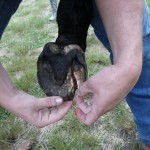My horse cut his hoof from toe to bulb top to bottom…
My horse cut his hoof from toe to bulb top to bottom….just besides the frog. The vet says he will be okay…if we can keep the hoof together and if doesn’t get infected. We are thinking a showing will hold it maybe one that attaches over the top of hoof as well. I have a picture as it is hard to explain…we are hoping the coffin bone is not affected though we are hopeful because just one day after he is putting full weight on the hoof. It is not his only injury as it was a trailering accident.The vet says he has never seen this before and neither has my farrier. We need advice as to what to do…the vet wrapped it in vet wrap and duck tape in an effort to hold it together and keep out bacteria. Any ideas…please.
CJF, Herb Richardson’s Reply
Kathi,
I’m having trouble trying to envision what this injury looks like. Try to send a picture, or several pictures from different angles, and I will give you my best opinionon what can be done in terms of shoeing.
Thank you for responding…I was at a loss and did not know if anyone could help us.
This first picture is of the injury when we first found it.
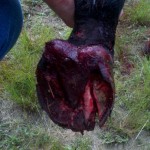
Serious Hoof Injury
The next showed it after it had been wrapped for 3 days so you can see how much it moves:
the next two are angles of the top of the hoof. And you can see my horse dented in the top of his hoof, thought the coronary band seems to still be straight.
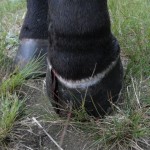
Hoof Injury Top View
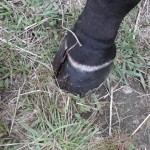
Hoof View 2
The final photo is what we have had done so far with his hoof to try to hold it together. It is basically a walking horse shoe with the metal strap over the top to hold the hoof together.
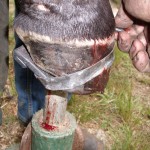
Hoof Repair
BTW my horses is a 5 year old TB…only raced twice. Strong healthy hooves until the broke the hoof kicking in the trailer accident. He sustained other injuries…bad scrapes on the inside and outside of the opposite leg, required stitches in his hip and over his left eye. Also had to have and artery above the broken hoof stitched up and close and he had lost a substantial amount of blood from there. The blood was originally hiding the hoof injury. This all came from freaking out in a slant load trailer and completely turning himself around while within the dividers going down the road. Right now we are just trying to find the best way to keep his hoof together while trying to grow it out quickly. Never encountered this before…many vets, not ours thankfully, think we should just put him down. Any ideas would be fabulous. 🙂 Thank you for your time! Hoof supplement ideas? Shoeing idea? Anything would be helpful! Thanks!!! Kathi
CJF, Herb Richardson’s Response:
Kathi,
WOW! This is an interesting injury. I think you have done well so far with the type of shoe and band that you are using. I have two suggestions. First, you might try wiring the crack in the manner that is typical for quarter cracks. While I don’t usually do that for quarter cracks, in most cases it is unnecessary, in this case it might be a good idea to stabilize the crack so that new growth can occur at the coronary band. The other suggestion would be to use antibiotic ointment of the type used for mastitis in dairy cattle to treat the wound. This would help keep any infection under control, is non-irritating to live tissue and would allow healthy new tissue growth. One more thing, I would not use any type of glue or patch on the crack that would seal off the wound, as that would make controlling and treating any infection more difficult. A hospital plate added to the bottom of the shoe would make it easier to keep clean and still be able to treat the bottom of the foot. Hope this helps and good luck with your horse.
“I have a horse that for over three months has been a little sore over his sole.”…
Not sore at the heal or middle third of frog like “Navicular”. His sole is not hard. It is not flaky but is soft. Does not seem to harden or grow out. Could there be some cause for this. I have never seen this before.
Dr. Kimberly Gryl’s Answer:
Jason:
Some horses have softer feet, and need to be supported for this. Your horse may be one of those who cannot go barefoot. Shoeing will usually remedy the sole tenderness, unless of course you are riding on rough ground. If he is already shod, you may try a sole toughener or paint. Also, the basis of every good foot is good nutrition. Regardless of what diet your horse eats, a hoof supplement is usually helpful in promoting a better, stronger hoof to grow.
“THE ONLY thing I can think that might be somewhat bothering him is in his right abscess hoof, he has a touch of thrush “…
I have an 18 year old TB gelding whom I have been barrel racing for 4 years. In mid June he was lame with an abscess in his right front hoof for about two weeks. I got it cleared up got him reset and took him to a barrel race at the end of June. He was fine all day, trail ride and all, I ran him in the Open 2D he did great at first and 2nd. He must of stepped wrong at third had a wide barrel coming out of it (very unlike him) and was short stepping on his hind when we left the arena. The next morning he was then again, 3 legged lame with another abscess in the same hoof.
He was then off for a month. I had the chiropractor to come work on him since he was surely out in the hind and I figured he was sore from gimping around with the abscess. His hooves were longer than I usually let them get, my farrier came and reset him as well as put a set of new shoes on. Jet was then out in his hind end again. My chiropractor came back out Sunday night worked on him for a good while. I gave him Monday off and thought I would ride him last night to see if he was back to normal as he hasn’t been cantering right since I started riding him after the last abscess episode.
I trotted him for at least a half hour to 45 mins doing circles and counter arcs and just doing “fun stuff.” I then asked him to canter. My horse isn’t the smooch and he lopes off type. He’s very much on the muscle and always has been. To get him to canter I roll my hips at the trot sit a little more forward and tell him to canter. He NORMALLY bounces around for a few laps of a circle then relaxes and collects himself. For the past few weeks and last night, I do as I always do and when he goes to pick up his canter he bounces around then plans his front end and spins swinging his hind end around his front. I cannot get him to move forward out of the spin. He will whoa but will not move forward. I got him to canter ONCE somewhat correctly yesterday to the left. I tried everything I knew how to do. I also got off of him and seen if he would lounge a canter. He lounged perfectly to the left but hassled me greatly to the right.
I HAVE NOT CHANGED ANY TACK ON HIM, everything I rode him in I’ve been using for a good while. I even tried changing bits and using different martingales yesterday when he just wouldn’t canter. I can get him to Breeze a straight line but he will not lope a straight line nor lope circles.
THE ONLY thing I can think that might be somewhat bothering him is in his right abscess hoof, he has a touch of thrush and I’ve been treating it. The thrush got into his hoof bulb and made it sore. He was a little lame on it for a few days but since I’ve been treating it he seems fine. I rode him on grass also to see if he would canter on a soft surface and it made an improvement.
Dr. Jack Sales’ Answer:
Hi Dawn,
I would think that the right hind that had the abscess is still bothering him some. It might be worthwhile to get an x-ray of that foot and make sure there isn’t something there that would be causing this long-term condition and might be something that can be resolved with the proper treatment. The Vet doing the x-ray can also examine the rest of the horse to make sure it may not be something else that is causing the problem.
“His hind hooves have become oddly shaped…”
We have an 23 yr old retired school horse who has severe hindlimb arthritis. We have been managing him well until about 2 weeks ago. He began to stand with his hind legs tucked more under his body and his hind hooves have become oddly shaped. The toes are almost flattened and are very squared off. Just trying to get a handle on what’s happening before any decisions are made. Thanks
Dr. Jack Sales’ Answer:
Hi Becky,
Regarding your 23 year old school horse with the arthritis. It sounds as if some part of his anatomy in the hind end has given way. The other possibility is that something has occurred in the front limbs that has caused more pain than he is used to and therefore he is trying to compensate by putting more weight on his hind limbs, which would possibly cause this change in the appearance of his hind hooves. I wish I could be more specific, but it will probably take an exam by your Veterinarian to determine exactly what is going on and what might be done to help him.
“What causes ‘gravels’?”
What causes “gravels” or abscesses in the sole of the horse’s hoof? Thanks.
Dr. Jack Sales’ Answer:
Hi Bob. Gravel, which is another term used for hoof or foot abscesses in the horse are normally caused by some penetration of bacteria into the sensitive part of the hoof. This would be up under the hard layer of the hoof and into the area where there is blood and nerve supply to the foot. This penetration can be caused by either a puncture wound through the sole or frog area of the bottom of the foot or filth that has penetrated through a separation at the white line or a crack in the hoof wall. Once the bacteria penetrate into the sensitive area (area with blood and nerve supply), they start an infection that causes swelling. Since the swelling has no where to expand because of the hard hoof wall, there is a great amount of pain caused by pressure on the nerve supply in this area. The abscess will move along the separation between the sensitive and insensitive areas of the foot in order to find a place to break and drain. This is usually at the coronary band, but sometimes there will be drainage at the white line. Abscesses are also thought to originate from a severe bruising of the sole, with no hoof penetration. Because of the bleeding at the bruised area, bacteria which may be circulating in the horses circulatory system could begin growing in this bruised area. This usually occurs 5 to 10 days after the bruising initially occurred. Another possible cause of foot abscesses would be a horseshoe nail being driven into the sensitive area of the hoof.

